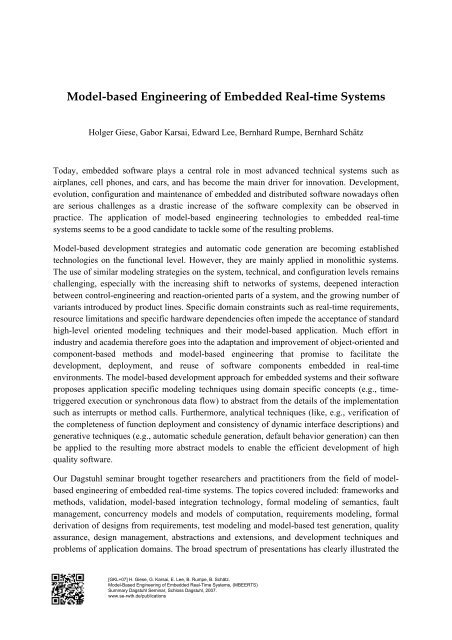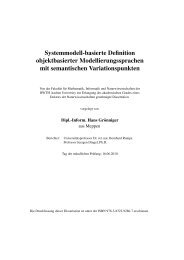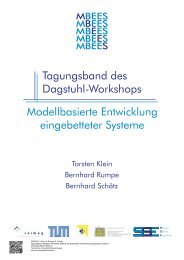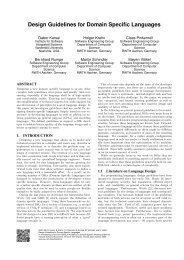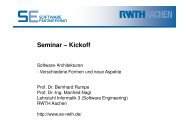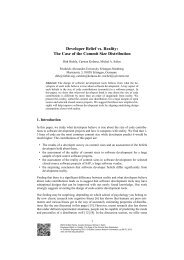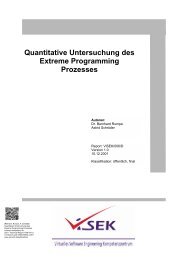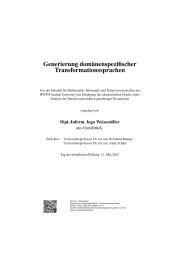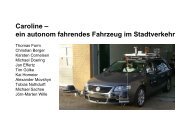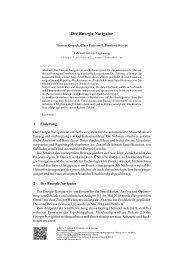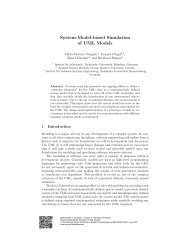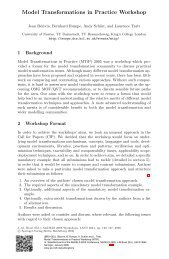Model-based Engineering of Embedded Real-time Systems
Model-based Engineering of Embedded Real-time Systems
Model-based Engineering of Embedded Real-time Systems
You also want an ePaper? Increase the reach of your titles
YUMPU automatically turns print PDFs into web optimized ePapers that Google loves.
<strong>Model</strong>-<strong>based</strong> <strong>Engineering</strong> <strong>of</strong> <strong>Embedded</strong> <strong>Real</strong>-<strong>time</strong> <strong>Systems</strong><br />
Holger Giese, Gabor Karsai, Edward Lee, Bernhard Rumpe, Bernhard Schätz<br />
Today, embedded s<strong>of</strong>tware plays a central role in most advanced technical systems such as<br />
airplanes, cell phones, and cars, and has become the main driver for innovation. Development,<br />
evolution, configuration and maintenance <strong>of</strong> embedded and distributed s<strong>of</strong>tware nowadays <strong>of</strong>ten<br />
are serious challenges as a drastic increase <strong>of</strong> the s<strong>of</strong>tware complexity can be observed in<br />
practice. The application <strong>of</strong> model-<strong>based</strong> engineering technologies to embedded real-<strong>time</strong><br />
systems seems to be a good candidate to tackle some <strong>of</strong> the resulting problems.<br />
<strong>Model</strong>-<strong>based</strong> development strategies and automatic code generation are becoming established<br />
technologies on the functional level. However, they are mainly applied in monolithic systems.<br />
The use <strong>of</strong> similar modeling strategies on the system, technical, and configuration levels remains<br />
challenging, especially with the increasing shift to networks <strong>of</strong> systems, deepened interaction<br />
between control-engineering and reaction-oriented parts <strong>of</strong> a system, and the growing number <strong>of</strong><br />
variants introduced by product lines. Specific domain constraints such as real-<strong>time</strong> requirements,<br />
resource limitations and specific hardware dependencies <strong>of</strong>ten impede the acceptance <strong>of</strong> standard<br />
high-level oriented modeling techniques and their model-<strong>based</strong> application. Much effort in<br />
industry and academia therefore goes into the adaptation and improvement <strong>of</strong> object-oriented and<br />
component-<strong>based</strong> methods and model-<strong>based</strong> engineering that promise to facilitate the<br />
development, deployment, and reuse <strong>of</strong> s<strong>of</strong>tware components embedded in real-<strong>time</strong><br />
environments. The model-<strong>based</strong> development approach for embedded systems and their s<strong>of</strong>tware<br />
proposes application specific modeling techniques using domain specific concepts (e.g., <strong>time</strong>triggered<br />
execution or synchronous data flow) to abstract from the details <strong>of</strong> the implementation<br />
such as interrupts or method calls. Furthermore, analytical techniques (like, e.g., verification <strong>of</strong><br />
the completeness <strong>of</strong> function deployment and consistency <strong>of</strong> dynamic interface descriptions) and<br />
generative techniques (e.g., automatic schedule generation, default behavior generation) can then<br />
be applied to the resulting more abstract models to enable the efficient development <strong>of</strong> high<br />
quality s<strong>of</strong>tware.<br />
Our Dagstuhl seminar brought together researchers and practitioners from the field <strong>of</strong> model<strong>based</strong><br />
engineering <strong>of</strong> embedded real-<strong>time</strong> systems. The topics covered included: frameworks and<br />
methods, validation, model-<strong>based</strong> integration technology, formal modeling <strong>of</strong> semantics, fault<br />
management, concurrency models and models <strong>of</strong> computation, requirements modeling, formal<br />
derivation <strong>of</strong> designs from requirements, test modeling and model-<strong>based</strong> test generation, quality<br />
assurance, design management, abstractions and extensions, and development techniques and<br />
problems <strong>of</strong> application domains. The broad spectrum <strong>of</strong> presentations has clearly illustrated the<br />
[GKL+07] H. Giese, G. Karsai, E. Lee, B. Rumpe, B. Schätz.<br />
<strong>Model</strong>-Based <strong>Engineering</strong> <strong>of</strong> <strong>Embedded</strong> <strong>Real</strong>-Time <strong>Systems</strong>, (MBEERTS)<br />
Summary Dagstuhl Seminar, Schloss Dagstuhl, 2007.<br />
www.se-rwth.de/publications
prevalence <strong>of</strong> model-<strong>based</strong> techniques in the embedded systems area, as well as progress in the<br />
field.<br />
The seminar included mostly conference-like presentations followed by short discussions, and<br />
three group discussion sessions with panels selected from the attendees. In all cases, the<br />
emphasis was on fostering interaction among the participants and on gaining new insights and<br />
better understanding. Most <strong>of</strong> the seminar participants provided abstracts and the slides for their<br />
presentations that are available on the Dagstuhl website for the seminar. We plan to compile a<br />
state-<strong>of</strong>-the-art survey on model-<strong>based</strong> development <strong>of</strong> embedded real-<strong>time</strong> systems addressing<br />
foundational issues, language engineering, domain-specific issues, and life-cycle issues. The<br />
survey will be <strong>based</strong> on contributions <strong>of</strong> the participants <strong>of</strong> the seminar and will be published in<br />
the Springer LNCS series.


